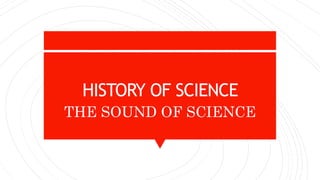
HISTORY OF SCIENCE By TEACHER You Know no
- 1. HISTORY OF SCIENCE THE SOUND OF SCIENCE
- 2. WHERE IT ALL STARTED The history of science covers the development of science from ancient times to the present. It encompasses all three major branches of science: natural, social, and formal. The earliest roots of science can be traced to Ancient Egypt and Mesopotamia in around 3000 to 1200 BCE. Their contributions to mathematics, astronomy, and medicine entered and shaped the Greek natural philosophy of classical antiquity, whereby formal attempts were made to provide explanations of events in the physical world based on natural causes. After the fall of the Western Roman Empire, knowledge of Greek conceptions of the world deteriorated in Latin-speaking Western Europe during the early centuries (400 to 1000 CE) of the Middle Ages, but continued to thrive in the Greek-speaking Eastern Roman (or Byzantine) Empire. Aided by translations of Greek texts, the Hellenistic worldview was preserved and absorbed into the Arabic-speaking Muslim world during the Islamic Golden Age.[5] The recovery and assimilation of Greek works and Islamic inquiries into Western Europe from the 10th to 13th century revived the learning of natural philosophy in the West Natural philosophy was transformed during the Scientific Revolution in 16th- to 17th-century European new ideas and discoveries departed from previous Greek conceptions and traditions New Science that emerged was more mechanistic in its worldview, more integrated with mathematics, and more reliable and open as its knowledge was based on a newly defined scientific method. More "revolutions" in subsequent centuries soon followed. The chemical revolution of the 18th century, for instance, introduced new quantitative methods and measurements for chemistry. In the 19th century, new perspectives regarding the conservation of energy, the age of the Earth, and evolution came into focus in the 20th century, new discoveries in genetics and physics laid the foundations for new subdisciplines such as molecular biology and particle physics. Moreover, industrial and military concerns as well as the increasing complexity of new research endeavors soon ushered in the era of "big science,“, particularly after the Second World War
- 3. THE HELP Before English became dominant, scientific publications were roughly equally split between French, German and English. This posed something of a problem: if scientists weren’t multilingual, they would miss out on others’ discoveries. With a universal language, researchers know what to expect, and how to find information. They know what language to publish in and how to search for other people’s articles that support their own work. Beyond published research, a universal language also helps make sure everyone has access to information in presentations, guidelines, and standards. English is suitable as an international language in a number of ways: on the surface, it’s easy enough to convey basic meanings when conducting trade, business, and tourism, and on news sites and social media
- 4. EMERGENCE OF CHEMISTRY A decisive moment came when "chemistry" was distinguished from alchemy by Robert Boyle in his work The Sceptical Chymist, in 1661; although the alchemical tradition continued for some time after his work. Other important steps included the gravimetric experimental practices of medicinal chemists like William Cullen, Joseph Black, Torbern Bergman, and Pierre Macquer and through the work of Antoine Lavoisier (“father of modern chemistry”) on oxygen and the law of conservation of mass, which refuted phlogiston theory. Modern chemistry emerged from the sixteenth through the eighteenth centuries through the material practices and theories promoted by alchemy, medicine, manufacturing, and mining.
- 5. THE HISTORY STILL CONTINUES On July 4, 2012, physicists working at CERN's Large Hadron Collider announced that they had discovered a new subatomic particle greatly resembling the Higgs boson, a potential key to an understanding of why elementary particles have mass and indeed to the existence of diversity and life in the universe. For now, some physicists are calling it a “Higgs-like" particle. Peter Higgs was one of six physicists, working in three independent groups, who, in 1964, invented the notion of the Higgs field ("cosmic molasses"). The others were Tom Kibble of Imperial College, London; Carl Hagen of the University of Rochester; Gerald Guralnik of Brown University; and François Englert and Robert Brout, both of Université libre de Bruxelles
- 6. QUESTIONS 1. WHO WERE THE MAIN COUNTRIES IN THE HISTORY OF SCIENCE 2. WHAT WAS THE CONTRIBUTION OF ENGLISH TO SCIENCE